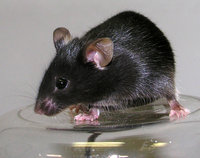Strain Data Sheet
RBRC01652
Strain Information | |
|---|---|
| Image |  |
| BRC No. | RBRC01652 |
| Type | Transgene |
| Species | Mus musculus |
| Strain name | IF2 |
| Former Common name | SB transposon IF2 |
| H-2 Haplotype | |
| ES Cell line | |
| Background strain | |
| Appearance | black |
| Strain development | Developed by Drs. Kyoji Horie and Junji Takeda at Osaka University in 2004. The SB transposon vecotor consists of a GFP expression cassette flanked by a splice donor and a lacZ cassette flanked by acceptor, allowing for poly (A)-trap selection of transposition events and promoter-trap for endogenous gene expression pattern profiling , respectively. This transposon vector was injected into the pronuclei of B6D2F2 fertilized egges. C57BL/6, DBA/2 and ICR mixed background. |
| Strain description | This transgenic mouse strain has a Sleeping Beauty (SB) transposon vector acting as a mutagen. The double transgenic mice containing SB transposon vector and SB transposase, generated by crossing with this Tg mice and the Tg mice having SB transposase, can be used to generate many mutant mice through germline transmission by breeding with wild-type mouse. |
| Colony maintenance | Backcross to C57BL/6 (Hemizygote x C57BL/6J) |
| References | Characterization of Sleeping Beauty transposition and its application to genetic screening in mice. Horie K, Yusa K, Yae K, Odajima J, Fischer S E, Keng V W, Hayakawa T, Mizuno S, Kondoh G, Ijiri T, Matsuda Y, Plasterk R H, Takeda J Mol. Cell. Biol., 23, 9189-9207 (2003). 14645530Region-specific saturation germline mutagenesis in mice using the Sleeping Beauty transposon system. Keng V W, Yae K, Hayakawa T, Mizuno S, Uno Y, Yusa K, Kokubu C, Kinoshita T, Akagi K, Jenkins N A, Copeland N G, Horie K, Takeda J Nat. Methods, 2, 763-769 (2005). 16179923 |
Health Report | |
|---|---|
| Examination Date / Room / Rack | |
Gene | |||||||
|---|---|---|---|---|---|---|---|
| Gene Symbol | Gene Name | Chr. | Allele Symbol | Allele Name | Common Names | Promoter | Diseases Related to This Gene |
| GFP | Green Fluorescent Protein (Aequorea victoria) | UN | CAG promoter (CMV-IE enhancer, chicken beta-actin promoter, rabbit beta-globin genomic DNA) | ||||
| IRES | internal ribosomal entry site (EMCV) | UN | |||||
| SA | Splice acceptor | UN | SA | ||||
| Splice donor | Splice donor | UN | Splice donor | ||||
| lacZ | beta-galactosidase (E. coli) | UN | |||||
| loxP | phage P1 loxP | UN | loxP | ||||
| loxP | phage P1 loxP | UN | loxP | ||||
| neo | neomycin resistance gene (E. coli) | UN | mouse phosphoglycerate kinase promoter (PGK promoter) | ||||
| nls | SV40 large T antigen nuclear localization signal (NLS) | UN | nls | ||||
Phenotype | |
|---|---|
| Annotation by Mammalian phenotyhpe ontology | |
| Detailed phenotype data | |
Ordering Information | |
|---|---|
| Donor DNA | pTrans-SA-IRESLacZ-CAG-GFP-SD:Neo[SA (The human bcl-2 intron 2/exon 3 splice acceptor sequence), Encephalomyocarditis virus (EMCV) internal ribosomal entry site (ires), E. coli lacZ, Simian virus 40 Large T antigen nuclear localization signal (nls), CAG promoter (CMV-IE enhancer, chicken beta-actin promoter, rabbit beta-globin genomic DNA), EGFP, SD(splice donor sequences from the mouse hprt gene), E.coli NEO, the mRNA instability signal derived from the 3′ untranslated region of the human granulocyte-macrophage colony-stimulating factor cDNA], mouse phosphoglycerate kinase promoter (PGK promoter) |
| Research application | Fluorescent Proteins/lacZ System |
| Specific Term and Conditions | The RECIPIENT of BIOLOGICAL RESOURCE shall obtain a prior written consent on use of it from the DEPOSITOR. In publishing the research results obtained by use of the BIOLOGICAL RESOURCE, a citation of the following literature(s) designated by the DEPOSITOR is requested. Nat. Methods., 2, 763-769 (2005). RECIPIENT which wants to use the BIOLOGICAL RESOURCE for the purpose other than education or not-for-profit research is requested to enter into a Material Transfer Agreement with Osaka University. |
| Depositor | Junji Takeda (Osaka University) |
| Strain Status |  Frozen embryos Frozen embryos Frozen sperm Frozen sperm |
| Strain Availability | Recovered litters from cryopreserved embryos (2 to 4 months) Cryopreserved sperm (within 1 month) Cryopreserved embryos (within 1 month) |
| Additional Info. | Necessary documents for ordering:
Genotyping protocol -PCR- |
BRC mice in Publications |
|---|
Nakata H, Hashimoto T, Seki Y, Mekada K, Obata Y, Yoshiki A. Simultaneous detection of multiple transgenes for genetically-modified mouse strains. Exp Anim 58(4) 437-42(2009) 19654444 |